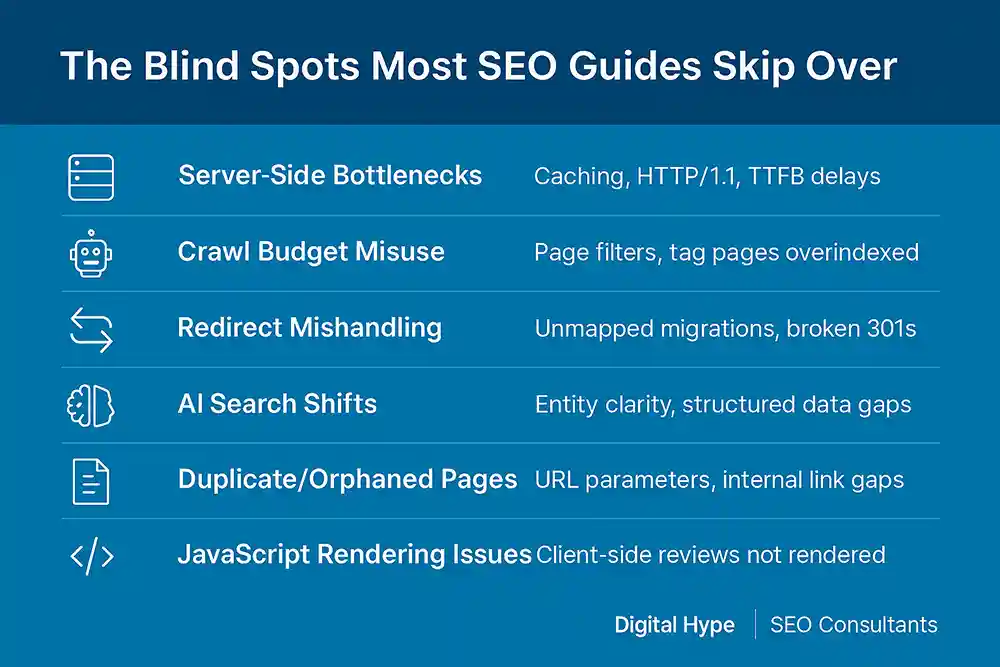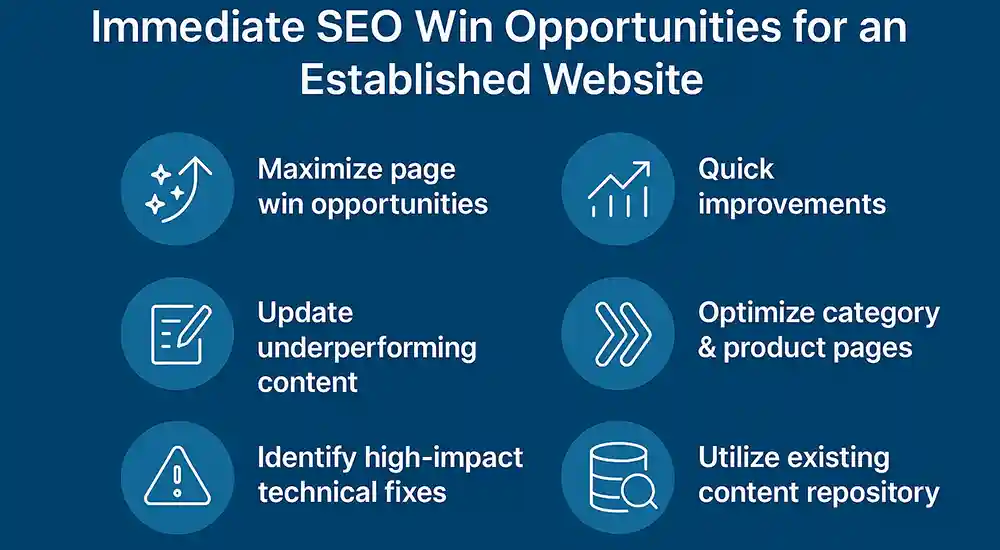Defining DIY SEO clearly
DIY SEO refers to business owners undertaking their own search engine optimisation tasks without hiring a full-time consultant or agency. It usually covers:
- On-page work like titles, headings and content
- Local SEO signals, such as directories and reviews
- Basic speed and usability tweaks
Where DIY usually struggles is with technical SEO, the crawl behaviour, server configuration, log analysis and structured data that sit under the bonnet. Most business owners can handle the visible front-end work, but the invisible back-end often decides whether all that effort sticks. For a deeper breakdown of what technical SEO really involves, see my SEO consultant page.
Why this question matters more than most owners realise
I hear it all the time across Bournemouth, Poole and Dorset: “Paul, can I just do my own SEO?”
The answer is yes, and in fact, you should. Understanding SEO gives you control, confidence, and resilience. However, the choice also affects how you spend your most valuable resource: time.
Go fully DIY and you’ll save money, but you may hit ceilings. Outsource everything too soon, and you’ll bleed budget on jobs you could have handled in a couple of hours a week. That balance point is where most owners go wrong.
The blind spots most guides skip over
Most SEO checklists talk about keywords, blogs, and backlinks. But they rarely cover the traps that actually sink sites:
- Server-side bottlenecks — poor caching headers, HTTP/1.1 connections, slow TTFB throttling Googlebot. (See MDN’s cache-control documentation).
- Crawl budget misuse — bots chewing through tag pages or filters while ignoring your money pages (Google: What crawl budget means).
- Redirect mishandling — migrations without mapped 301s wiping out 40% of traffic overnight (Moz site migration guide).
- AI search shifts — Google’s AI Overviews and Bing Copilot now rely heavily on entity clarity and structured data to choose who they cite.
A Dorset retailer I supported thought they could redesign without a redirect plan. Overnight, their traffic halved. It took three months of remapping and revalidation to recover. That kind of pain rarely shows up in generic guides.
Other blind spots include duplicate content from URL parameters, orphaned pages with no internal links, and index bloat from category archives. I’ve also seen Dorset firms use JavaScript review widgets that never render in Google’s HTML snapshot, meaning the reviews they thought were helping SEO were invisible to search engines. Misused schema, expired SSLs, and keyword cannibalisation across service pages are equally common traps.
If you want practical breakdowns of these blind spots, I’ve documented them further in my SEO tips and guides.

The short wins vs the long slog
Short wins in SEO feel great because they’re visible and fast. Change a handful of title tags, and impressions rise within a week. Compress bloated images with tools like TinyPNG and PageSpeed Insights rewards you instantly. Publish a new service page for “Boiler Repairs Poole” and you’ll sometimes see phone calls coming in within a month. These are the fixes business owners love because they feel like progress.
But the long slog is where real growth happens. Building authority clusters, groups of service pages and supporting guides that reinforce each other takes months. Keeping Core Web Vitals stable across templates isn’t a one-off tweak; it’s a discipline. Gathering a steady stream of genuine reviews doesn’t happen in a week, but drip-feeds trust signals into Google over the course of a year.
The danger is that many DIY owners get addicted to the quick wins. They change a few titles, see a lift, and assume the job is done. Six months later, traffic flatlined because there was no system in place to sustain growth. I saw this with a Bournemouth tradesman who published a rush of service pages one summer. By winter, enquiries dried up, the pages hadn’t been refreshed, no supporting content was built, and competitors with deeper clusters overtook them.
The truth is, you need both. Short wins keep you motivated and prove that effort works. The long slog builds the foundations so those wins don’t slip away. SEO is like fitness: a single workout feels great, but the transformation only comes with routine.
A contrarian take: stop writing “ultimate guides”
Owners often spend months on 5,000-word “ultimate guides.” Stop. If your service pages don’t convert, guides won’t save you. Always fix the roof before painting the walls.
Where DIY works brilliantly
I’ve seen Dorset cafés, accountants, and tradespeople lift rankings themselves by:
- Writing service pages in plain English, answering client questions
- Making their sites mobile-friendly with off-the-shelf templates
- Building internal links between blogs and services
- Asking customers for reviews and embedding them
A Bournemouth café once added its menu online with proper headers and alt text. Within six weeks they were ranking for “vegan breakfast Bournemouth” and weekend bookings rose. That’s DIY at its best.
Practical SEO examples: Good, Better, Best
Sometimes owners just need to see it.
Title tag
- Good: “Plumbing Services”
- Better: “Plumbing Services in Bournemouth”
- Best: “Emergency Plumbing Services in Bournemouth | 24/7 Local Plumbers”
Alt text
- Good: “Image of sink”
- Better: “Plumber fixing kitchen sink”
- Best: “Bournemouth plumber fixing leaking kitchen sink pipe”
Internal link
- Good: “Click here for more”
- Better: “See our kitchen fitting guide”
- Best: “See our Bournemouth kitchen fitting guide for step-by-step advice”
These small shifts compound into bigger wins over time.

Where consultants save you months of trial and error
Think of SEO like car maintenance. Changing a bulb? DIY. Replacing the gearbox? Call a mechanic.
I once had a Poole estate agent in a panic: half their pages had vanished from Google. The issue wasn’t with the content; it was with the cache headers broken by a plugin update. A 30-minute technical fix restored their crawl. Left unchecked, it would have cost them months of leads.
These hidden, under-the-hood fixes are why working with an SEO consultancy sometimes is worth every penny.
DIY vs Consultant — Who Should Do What
| Area | DIY Owner Tasks | Consultant Added Value |
|---|---|---|
| Content & On-Page | Titles, meta descriptions, headers, alt text, FAQs, internal links | Entity mapping, content architecture, competitive gap analysis, multi-type schema strategy |
| Local SEO | Core directories, NAP consistency, reviews, location pages | Structured citations at scale, multi-location logic, local PR links, review workflows |
| Technical SEO | Plugin hygiene, image compression, basic caching | Log analysis, crawl budget tuning, canonicals/pagination, hreflang, faceted nav control |
| Server-Side SEO | Monitor uptime; basic CDN toggle | HTTP/2–3, TLS, Brotli, cache headers, edge rules, origin shielding, bot bottleneck removal |
| Migrations | Small redirect tweaks; content freeze | Full redirect mapping, staging validation, launch monitoring, rollback plan |
| Measurement | GSC/GA4 checks, simple goals | GTM setup, attribution models, KPI dashboards, alerting |
| AI & Structured Data | Basic FAQ rich results | Multi-type schema, entity disambiguation, AI-answer surfacing tests |
Self-diagnostic quiz: Can you DIY this?
Self-diagnostic quiz: Can you DIY this?
Answer yes or no:
- I can log into Google Search Console and find the Pages report.
- I know how to edit page titles and descriptions in my CMS.
- I’ve written at least one FAQ page.
- I can compress an image before upload.
- I know how to set up a 301 redirect.
- I’ve checked PageSpeed Insights recently.
- I understand what a canonical tag is.
- I can access hosting/CDN caching settings.
- I’ve validated schema markup with Google’s Rich Results Test.
- I know how to track leads from organic search.
- I can run a crawl with the free Screaming Frog SEO Spider and review results.
Scoring
0–3 “yes”: DIY starter. Focus on basics, get help for tech.
4–7 “yes”: Hybrid DIY. Handle a lot, but book quarterly technical checks.
8–10 “yes”: Consultant level. Time is your only bottleneck.
The 30-Day DIY SEO Plan
| Week | Focus | Actions | Owner Check |
|---|---|---|---|
| Week 1 | Foundations |
• Set up Google Search Console & GA4 • Submit XML sitemap; fix “noindex”/404s • PageSpeed check on top 5 pages |
Dashboard access working; key errors noted |
| Week 2 | On-Page Essentials |
• Rewrite titles & H1s for intent • Add 3–5 internal links to each money page • Compress/rename images; add descriptive alt text |
CTR up on top pages; images optimised |
| Week 3 | Helpful Content |
• Publish 2 customer-question guides with FAQs • Add evidence blocks (photos, process, pricing cues) • Link guides → service pages |
Guides indexed; internal links live |
| Week 4 | Local Signals |
• Build/clean NAP citations (UK directories) • Add service-area/location pages • Request 3 new reviews; embed and reference them |
NAP consistent; new reviews published |
Time vs Effort SEO Model
| Weekly Time | What You Can Realistically Do | Expected Outcomes (3–6 months) |
|---|---|---|
| 2 hours |
• Update titles & meta descriptions • Add 1–2 internal links per week • Publish/refresh one short FAQ • Check GSC for coverage errors |
• Modest CTR lift on key pages • Core service pages indexed • Early local rankings • Baseline technical health (simple sites) |
| 4 hours |
• All 2h tasks, plus: • Write a new blog/guide every 2 weeks • Optimise images & alt text • Build/clean a few local citations • Run PageSpeed and fix simple issues |
• Noticeable rise in impressions & clicks • Snippet wins on service/FAQ pages • Stronger local presence (more calls/visits) • Faster load speeds; lower bounce rates |
| 8 hours |
• All 4h tasks, plus: • Publish 2–3 quality guides/month • Create service-area landing pages • Proactively seek local PR/links • Deeper crawl/index audits; structured data |
• Strong rankings across local & niche terms • Branded searches growing • Organic leads rival paid campaigns • AI overview visibility when entities are clear |
Local SEO if you don’t have Google Business Profile
| Priority | Action | Why It Helps |
|---|---|---|
| High | Dedicated location/service-area pages with full contact details and embedded map | Replaces some GBP signals; clarifies geography and intent |
| High | Citations on UK directories (Yell, Thomson Local, Bing Places) with consistent NAP | Confirms legitimacy and location to crawlers |
| Medium | Third-party reviews (Trustpilot, Facebook) linked from site | Evidence pattern while GBP is unavailable |
| Medium | Local PR/link opportunities (Bournemouth/Poole charities, clubs, chambers) | Authoritative local backlinks and brand searches |
| Low | Regular social posts pointing to location pages | Builds branded demand and encourages index refresh |
Migration break-glass box
Migration Break-Glass Box
If you’re about to redesign, replatform, or migrate your website, use this checklist before pressing “go.” A missed step can erase years of SEO gains overnight. For a deeper walkthrough, see the Moz Site Migration Guide.
- Freeze content changes at least one week before launch.
- Build a full redirect map — every old URL must point to a relevant new one.
- Validate on staging — test redirects, canonicals, robots.txt, and sitemaps before go-live.
- Choose a soft launch window — never on Friday night or peak sales hours.
- Monitor in real time using server logs and Google Search Console coverage reports.
- Rollback plan ready — ensure DNS, backups, and old hosting can be reinstated if things go wrong.
Case in point: A Bournemouth retailer launched on a Friday without redirects. By Monday, half their traffic had disappeared. Don’t repeat that mistake.
Insider truths only pros share
- Crawl frequency is earned. Publish junk and bots visit less.
- Plugins can’t fix messy architecture.
- Evidence is gold: photos, reviews, data tables.
- AI search is entity-first. Schema clarity decides if you get cited.
If you’d like real-world breakdowns of these traps, see my SEO tips blog.
Schema demo for SEO: entity clarity in action
Schema demo for SEO: entity clarity in action
This example ties an organisation to a core service and an FAQ block. Drop the JSON-LD into your site’s <head>. Validate it with Google’s Rich Results Test.
{
"@context": "https://schema.org",
"@type": "Article",
"headline": "DIY SEO for Business Owners",
"author": { "@type": "Person", "name": "Bob Smith" },
"publisher": { "@id": "https://example.co.uk/#org" },
"mainEntityOfPage": {
"@type": "WebPage",
"@id": "https://example.co.uk/services/online-marketing/"
},
"about": {
"@type": "Service",
"serviceType": "SEO Consulting",
"provider": { "@id": "https://example.co.uk/#org" }
},
"mainEntity": {
"@type": "FAQPage",
"name": "DIY SEO FAQs",
"hasPart": [{
"@type": "Question",
"name": "Can I do my own SEO?",
"acceptedAnswer": {
"@type": "Answer",
"text": "Yes. Focus on content, on-page basics and local citations; bring in a consultant for technical issues."
}
},{
"@type": "Question",
"name": "When should I hire a consultant?",
"acceptedAnswer": {
"@type": "Answer",
"text": "Site migrations, server-side performance, crawl/index issues, complex schema and analytics implementation."
}
}]
}
}Technical SEO triage SOP
Technical SEO triage SOP
This is the 8-step process I run when something feels “off”. It focuses on real crawl behaviour, not just dashboards.
- Log sampling: pull server logs to see how Googlebot actually crawls (status codes, depth, patterns).
- Crawl diff: run a before/after crawl (e.g., Screaming Frog) to spot duplication, missing pages, and regressions.
- Robots & canonicals: confirm nothing critical is blocked or canonicalised away by mistake.
- Redirect integrity: test for chains, loops, stray 302s; map old → new URLs comprehensively.
- Cache headers & compression: validate Cache-Control, Brotli/Gzip and expiry rules at template and asset level.
- Core Web Vitals (lab vs field): compare Lighthouse lab data with field data via the Chrome UX Report to prioritise real-user fixes.
- Template audit: check common elements for bloat (fonts, images, unused scripts), H1 placement, CLS sources.
- Prioritised fix list: sort actions by impact vs effort; assign owners and timelines.
Need clarity on the technical side?
I offer a one-off Technical SEO Triage for independent owners. You’ll get a crawl review, speed insights, and a prioritised fix list — no jargon, no retainer.
Book My TriagePrefer to DIY? Browse my SEO tips & guides for step-by-step help.
DIY SEO FAQs: straight answers for busy business owners
Can I really do my own SEO as a small business owner?
Yes. Most owners can handle on-page basics, writing helpful content, building local citations, fixing images, and simple speed improvements. Save a consultant for technical SEO, migrations, and server-side performance.
Q2. How long until DIY SEO changes show results?
Small lifts usually appear within 4–6 weeks (click-through rate, impressions). Larger improvements typically take 3–6 months. If nothing moves after 8–12 weeks, check indexing in Google Search Console and run a PageSpeed test.
What should I do first if I only have two hours this week?
Prioritise:
Rewrite titles and meta descriptions on your top 3 pages.
Add a couple of internal links pointing to those pages.
Compress large images and add descriptive alt text.
Do I need blog posts or service pages first?
Focus on service pages first, they convert into customers. Use blog posts later to answer specific questions and link back to those services.
How do I choose keywords without paying for a tool?
Use what customers actually say and what Google suggests:
Note the top 5 questions customers ask you.
Type your service into Google and look at Autocomplete and “People also ask.”
Check queries in Google Search Console → Performance → Queries.
How do I improve page titles and meta descriptions?
Follow a simple formula:
Title: Service + Location + Proof cue (e.g. “Emergency Plumbing Bournemouth | 24/7 Local Plumbers”).
Meta: One benefit + clear action (e.g. “Same-day repairs, transparent pricing. Call today.”).
Why isn’t my page indexed and how do I fix it?
Check Google Search Console → Pages. Ensure the page isn’t blocked, is linked from your navigation, and doesn’t return errors. Request re-indexing once fixed.
My site is slow. What can I fix without a developer?
Start with:
Compress and resize images (use WebP).
Remove unused plugins and scripts.
Limit fonts — system fonts or one webfont only.
What is crawl budget and should I care?
It’s how often Googlebot crawls your site. On small sites it’s rarely a limit, but wasted crawl on junk pages can slow you down. Noindex thin archives, fix parameter bloat, and ensure money pages are within 2–3 clicks.
Do I need backlinks? How do I get safe local links?
Yes, but quality matters more than quantity. Get links from local directories, sponsorships, chambers, and genuine mentions in press or blogs.
Can I rank locally without a Google Business Profile?
Yes, but it’s harder. Strengthen on-site location signals with service-area pages, consistent UK citations, and reviews or case studies showing local proof.
How many internal links should a page have?
There’s no magic number. Aim for clarity: each page should link up to a parent and across to 2–3 related pages. Use descriptive anchor text.
What is schema and which types should I add first?
Schema is structured data that helps Google understand your site. Start with Organisation (or LocalBusiness), Service, and FAQPage. Always validate with Google’s Rich Results Test.
How do AI Overviews affect small businesses?
AI features highlight clear entities and concise answers. Use schema, write Q&A style content, and show evidence such as photos, pricing cues, and reviews.
When should I hire an SEO consultant instead of DIY?
Hire one if you’re migrating a site, fixing crawl/indexing issues, handling sudden traffic drops, or if you simply don’t have the time.
How do I measure leads if most people phone instead of filling a form?
Use call tracking numbers on key pages, track click-to-call buttons in GA4, and monitor branded searches alongside traffic.
Monthly SEO Ritual (10-minute checklist)
Monthly SEO Ritual (10-minute checklist)
Set a timer for ten minutes. This light maintenance prevents months of drift.
- Open Google Search Console → Pages → review new errors and “Crawled, not indexed”.
- Check top 10 pages for CTR under ~2% and refresh titles/descriptions if needed.
- Add one new internal link to a revenue-generating page (from a relevant post or page).
- Refresh one piece of content with a recent stat, image, or case snippet.
- Run PageSpeed Insights on the homepage and a key service page; note any regressions.
Final Word on Doing Your Own SEO
Independent owners can, and should, handle much of their own SEO. It’s empowering, cost-saving, and builds resilience. But pretending you don’t need technical expertise is like ignoring a crack in your shop’s foundation.
My advice is simple: cover 80% yourself, and bring in a consultant for the 20% that makes or breaks you. That 20% is where traffic collapses or growth stalls.
DIY SEO isn’t a binary yes or no. It’s yes, but with a safety net.
Ready to take your SEO further?
You’ve seen what you can achieve on your own. But if you’d like to save months of trial and error, I offer hands-on help with the tricky 20% — technical audits, migrations, crawl analysis and performance tuning.
Work With an SEO ConsultantOr, if you’d rather keep learning, browse my SEO guides for practical DIY advice.


